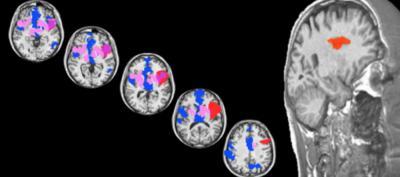The anterior insula region deep inside the brain controls how quickly people make decisions about love, according to a new paper.
The finding, made in an examination of a 48-year-old man who suffered a stroke, is the first causal clinical evidence that the anterior insula "plays an instrumental role in love," according to Stephanie Cacioppo, Director of the Center for Cognitive and Social Neuroscience Laboratory of the University of Chicago, lead author of the study who also helped create an evolutionary theory of loneliness.
In an earlier paper on the topic, Cacioppo and colleagues defined love as "an intentional state for intense [and long-term] longing for union with another" while lust, or sexual desire, is characterized by an intentional state for a short-term, pleasurable goal.
In this fMRI brain image correlation paper, the patient made decisions normally about lust but showed slower reaction times when making decisions about love, in contrast to neurologically typical participants matched on age, gender and ethnicity.
"This distinction has been interpreted to mean that desire is a relatively concrete representation of sensory experiences, while love is a more abstract representation of those experiences," said Cacioppo, a research associate and assistant professor in psychology. The new data suggest that the posterior insula, which affects sensation and motor control, is implicated in feelings of lust or desire, while the anterior insula has a role in the more abstract representations involved in love.

fMRI scans were intepreted to mean that brain regions activated by sexual desire are in blue and love are pink in healthy patients. The overlap in red illustrates how a patient's brain lesion affected the area in the brain associated with decision-making in love. Credit: Courtesy of Chris Frum and James Lewis/West Virginia University; Robin Weiss/University of Chicago
In the earlier paper, "The Common Neural Bases Between Sexual Desire and Love: A Multilevel Kernel Density fMRI Analysis," Cacioppo and colleagues examined a number of studies of brain scans that looked at differences between love and lust.
The studies showed consistently that the anterior insula was associated with love, and the posterior insula was associated with lust. However, as in all fMRI studies, the findings were correlational.
"We reasoned that if the anterior insula was the origin of the love response, we would find evidence for that in brain scans of someone whose anterior insula was damaged," she said.
In the study, researchers examined a 48-year-old heterosexual male in Argentina, who had suffered a stroke that damaged the function of his anterior insula. He was matched with a control group of seven Argentinian heterosexual men of the same age who had healthy anterior insula.
The patient and the control group were shown 40 photographs at random of attractive, young women dressed in appealing, short and long dresses and asked whether these women were objects of sexual desire or love. The patient with the damaged anterior insula showed a much slower response when asked if the women in the photos could be objects of love.
"The current work makes it possible to disentangle love from other biological drives," the authors wrote. Such studies also could help researchers examine feelings of love by studying neurological activity rather than subjective questionnaires.






Comments